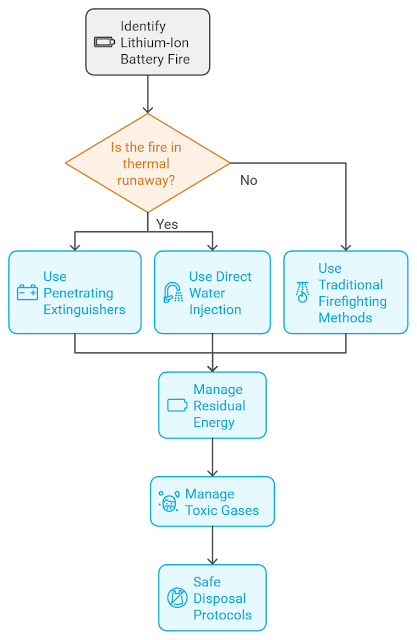The previous posts in this series examined the robust safety measures built into EV batteries and the rigorous testing they undergo. But what happens when those safety nets fail? While rare, lithium-ion battery fires do occur, demanding a specific approach to ensure the situation is handled swiftly and securely. This week, we'll explore the unique challenges of lithium-ion battery fires and how first responders and others are adapting to address them.
One of the biggest challenges with these fires is the potential for thermal runaway, a chain reaction within the battery that releases a tremendous amount of energy in the form of heat and flammable gases. Unlike a typical car fire that can be extinguished relatively quickly, a battery in thermal runaway can burn for hours, reignite even after appearing extinguished, and release harmful gases.
To complicate matters, the methods used to combat traditional fires aren’t always effective, and can even be dangerous, when dealing with lithium-ion batteries. That’s why researchers are continually working to develop new techniques and strategies, including those that involve directly targeting the source of the problem:
- Penetrating Extinguishers: These specialised tools are designed to pierce through the protective casing of a battery pack and deliver a fine water mist directly to the heart of the fire. By cooling the individual cells from the inside out, these extinguishers can effectively suppress thermal runaway and prevent the fire from spreading.
- Direct Water Injection: Research conducted by the Swedish Civil Contingencies Agency (MSB) demonstrated that flooding a burning battery with water, while simultaneously penetrating its casing, can be a highly effective method of extinguishment. However, the sources stress that this must be done with extreme caution and using the appropriate equipment to avoid creating dangerous jet flames and potential explosions.
These new approaches are already making a difference, significantly reducing the time and resources needed to extinguish lithium-ion battery fires.
However, knowing how to put out the fire is only half the battle. Proper disposal of damaged batteries is equally critical:- Residual Energy: Even after a fire is extinguished, damaged batteries can retain residual electrical and chemical energy, posing a risk of reignition hours, days, or even weeks later. This makes handling and transporting them a delicate process.
- Toxic Gases: Burning lithium-ion batteries release a cocktail of toxic gases, including hydrogen fluoride (HF) and hydrogen cyanide (HCN). While the sources note that HF levels in smoke from these fires are generally below those considered acutely toxic, exposure can still cause respiratory irritation, and precautions should be taken. In contrast, HCN is a potent poison that requires immediate treatment. First responders are trained to recognize the signs of exposure to these gases and administer the appropriate medical attention.
- Safe Disposal: Given these risks, damaged batteries must be handled and disposed of following specific safety protocols. This often involves storing them in a controlled environment, such as a dedicated container filled with sand or a special electrolyte solution, to prevent re-ignition and contain any potential leaks.
As the number of electric vehicles on our roads continues to rise, so too will the importance of understanding the unique challenges of lithium-ion battery fires. Through ongoing research, innovative firefighting techniques, and comprehensive safety protocols, we can work towards mitigating the risks associated with these fires and ensuring the continued success of the electric revolution.
Section | Article 1 | Article 2 | Article 3 (Same Page)
More:
Section:
Article:
- EV Battery Safety: How Manufacturers Protect You From Day One
- EV Battery Testing: The Intense Trials for Ultimate Safety
- Lithium-Ion Battery Fires: What to Do and How to Stay Safe
- Why Lithium ion Batteries catch fire?
- Electric Vehicle Fires: Understanding the Causes, Propagation, and Prevention Strategies
- Topic 7: What to Do in Case of a Li-ion Cell Fire?


Comments
Post a Comment